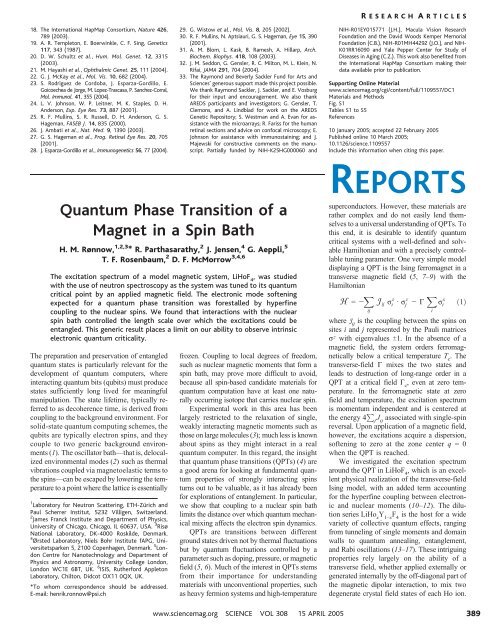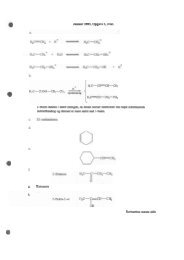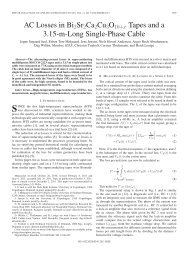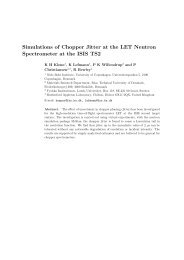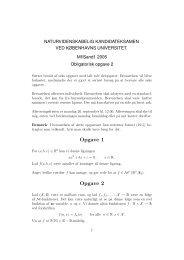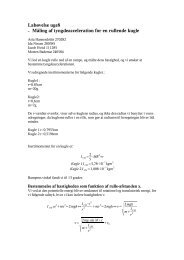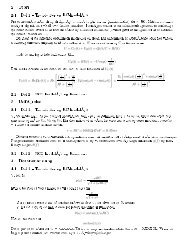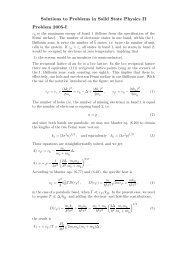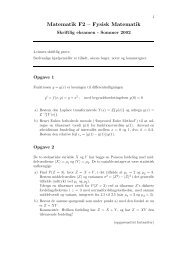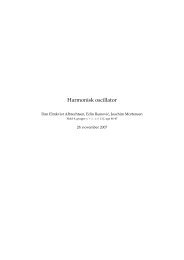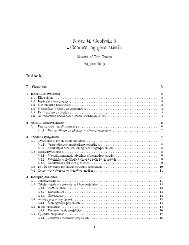Quantum Phase Transition of a Magnet in a Spin Bath
Quantum Phase Transition of a Magnet in a Spin Bath
Quantum Phase Transition of a Magnet in a Spin Bath
You also want an ePaper? Increase the reach of your titles
YUMPU automatically turns print PDFs into web optimized ePapers that Google loves.
R ESEARCHA RTICLES18. The International HapMap Consortium, Nature 426,789 (2003).19. A. R. Templeton, E. Boerw<strong>in</strong>kle, C. F. S<strong>in</strong>g, Genetics117, 343 (1987).20. D. W. Schultz et al., Hum. Mol. Genet. 12, 3315(2003).21. M. Hayashi et al., Ophthalmic Genet. 25, 111 (2004).22. G. J. McKay et al., Mol. Vis. 10, 682 (2004).23. S. Rodríguez de Cordoba, J. Esparza-Gordillo, E.Goicoechea de Jorge, M. Lopez-Trascasa, P. Sanchez-Corral,Mol. Immunol. 41, 355 (2004).24. L. V. Johnson, W. P. Leitner, M. K. Staples, D. H.Anderson, Exp. Eye Res. 73, 887 (2001).25. R. F. Mull<strong>in</strong>s, S. R. Russell, D. H. Anderson, G. S.Hageman, FASEB J. 14, 835 (2000).26. J. Ambati et al., Nat. Med. 9, 1390 (2003).27. G. S. Hageman et al., Prog. Ret<strong>in</strong>al Eye Res. 20, 705(2001).28. J. Esparza-Gordillo et al., Immunogenetics 56, 77 (2004).29. G. Wistow et al., Mol. Vis. 8, 205 (2002).30. R. F. Mull<strong>in</strong>s, N. Aptsiauri, G. S. Hageman, Eye 15, 390(2001).31. A. M. Blom, L. Kask, B. Ramesh, A. Hillarp, Arch.Biochem. Biophys. 418, 108 (2003).32. J. M. Seddon, G. Gensler, R. C. Milton, M. L. Kle<strong>in</strong>, N.Rifai, JAMA 291, 704 (2004).33. The Raymond and Beverly Sackler Fund for Arts andSciences’ generous support made this project possible.We thank Raymond Sackler, J. Sackler, and E. Vosburgfor their <strong>in</strong>put and encouragement. We also thankAREDS participants and <strong>in</strong>vestigators; G. Gensler, T.Clemons, and A. L<strong>in</strong>dblad for work on the AREDSGenetic Repository; S. Westman and A. Evan for assistancewith the microarrays; R. Fariss for the humanret<strong>in</strong>al sections and advice on confocal microscopy; E.Johnson for assistance with immunosta<strong>in</strong><strong>in</strong>g; and J.Majewski for constructive comments on the manuscript.Partially funded by NIH-K25HG000060 and<strong>Quantum</strong> <strong>Phase</strong> <strong>Transition</strong> <strong>of</strong> a<strong>Magnet</strong> <strong>in</strong> a Sp<strong>in</strong> <strong>Bath</strong>H. M. Rønnow, 1,2,3 * R. Parthasarathy, 2 J. Jensen, 4 G. Aeppli, 5T. F. Rosenbaum, 2 D. F. McMorrow 3,4,6The excitation spectrum <strong>of</strong> a model magnetic system, LiHoF 4, was studiedwith the use <strong>of</strong> neutron spectroscopy as the system was tuned to its quantumcritical po<strong>in</strong>t by an applied magnetic field. The electronic mode s<strong>of</strong>ten<strong>in</strong>gexpected for a quantum phase transition was forestalled by hyperf<strong>in</strong>ecoupl<strong>in</strong>g to the nuclear sp<strong>in</strong>s. We found that <strong>in</strong>teractions with the nuclearsp<strong>in</strong> bath controlled the length scale over which the excitations could beentangled. This generic result places a limit on our ability to observe <strong>in</strong>tr<strong>in</strong>sicelectronic quantum criticality.The preparation and preservation <strong>of</strong> entangledquantum states is particularly relevant for thedevelopment <strong>of</strong> quantum computers, where<strong>in</strong>teract<strong>in</strong>g quantum bits (qubits) must producestates sufficiently long lived for mean<strong>in</strong>gfulmanipulation. The state lifetime, typically referredto as decoherence time, is derived fromcoupl<strong>in</strong>g to the background environment. Forsolid-state quantum comput<strong>in</strong>g schemes, thequbits are typically electron sp<strong>in</strong>s, and theycouple to two generic background environments(1). The oscillator bath—that is, delocalizedenvironmental modes (2) suchasthermalvibrations coupled via magnetoelastic terms tothe sp<strong>in</strong>s—can be escaped by lower<strong>in</strong>g the temperatureto a po<strong>in</strong>t where the lattice is essentially1 Laboratory for Neutron Scatter<strong>in</strong>g, ETH-Zürich andPaul Scherrer Institut, 5232 Villigen, Switzerland.2 James Franck Institute and Department <strong>of</strong> Physics,University <strong>of</strong> Chicago, Chicago, IL 60637, USA. 3 RisøNational Laboratory, DK-4000 Roskilde, Denmark.4 Ørsted Laboratory, Niels Bohr Institute fAPG, Universitetsparken5, 2100 Copenhagen, Denmark. 5 LondonCentre for Nanotechnology and Department <strong>of</strong>Physics and Astronomy, University College London,London WC1E 6BT, UK.6 ISIS, Rutherford AppletonLaboratory, Chilton, Didcot OX11 0QX, UK.*To whom correspondence should be addressed.E-mail: henrik.ronnow@psi.chfrozen. Coupl<strong>in</strong>g to local degrees <strong>of</strong> freedom,such as nuclear magnetic moments that form asp<strong>in</strong> bath, may prove more difficult to avoid,because all sp<strong>in</strong>-based candidate materials forquantum computation have at least one naturallyoccurr<strong>in</strong>g isotope that carries nuclear sp<strong>in</strong>.Experimental work <strong>in</strong> this area has beenlargely restricted to the relaxation <strong>of</strong> s<strong>in</strong>gle,weakly <strong>in</strong>teract<strong>in</strong>g magnetic moments such asthose on large molecules (3); much less is knownabout sp<strong>in</strong>s as they might <strong>in</strong>teract <strong>in</strong> a realquantum computer. In this regard, the <strong>in</strong>sightthat quantum phase transitions (QPTs) (4) area good arena for look<strong>in</strong>g at fundamental quantumproperties <strong>of</strong> strongly <strong>in</strong>teract<strong>in</strong>g sp<strong>in</strong>sturns out to be valuable, as it has already beenfor explorations <strong>of</strong> entanglement. In particular,we show that coupl<strong>in</strong>g to a nuclear sp<strong>in</strong> bathlimits the distance over which quantum mechanicalmix<strong>in</strong>g affects the electron sp<strong>in</strong> dynamics.QPTs are transitions between differentground states driven not by thermal fluctuationsbut by quantum fluctuations controlled by aparameter such as dop<strong>in</strong>g, pressure, or magneticfield (5, 6). Much <strong>of</strong> the <strong>in</strong>terest <strong>in</strong> QPTs stemsfrom their importance for understand<strong>in</strong>gmaterials with unconventional properties, suchas heavy fermion systems and high-temperatureNIH-R01EY015771 (J.H.), Macula Vision ResearchFoundation and the David Woods Kemper MemorialFoundation (C.B.), NIH-R01MH44292 (J.O.), and NIH-K01RR16090 and Yale Pepper Center for Study <strong>of</strong>Diseases <strong>in</strong> Ag<strong>in</strong>g (C.Z.). This work also benefited fromthe International HapMap Consortium mak<strong>in</strong>g theirdata available prior to publication.Support<strong>in</strong>g Onl<strong>in</strong>e Materialwww.sciencemag.org/cgi/content/full/1109557/DC1Materials and MethodsFig. S1Tables S1 to S5References10 January 2005; accepted 22 February 2005Published onl<strong>in</strong>e 10 March 2005;10.1126/science.1109557Include this <strong>in</strong>formation when cit<strong>in</strong>g this paper.REPORTSsuperconductors. However, these materials arerather complex and do not easily lend themselvesto a universal understand<strong>in</strong>g <strong>of</strong> QPTs. Tothis end, it is desirable to identify quantumcritical systems with a well-def<strong>in</strong>ed and solvableHamiltonian and with a precisely controllabletun<strong>in</strong>g parameter. One very simple modeldisplay<strong>in</strong>g a QPT is the Is<strong>in</strong>g ferromagnet <strong>in</strong> atransverse magnetic field (5, 7–9) with theHamiltonianH 0 j X J ij si z I sj z j G X six ð1Þijiwhere J ijis the coupl<strong>in</strong>g between the sp<strong>in</strong>s onsites i and j represented by the Pauli matricess z with eigenvalues T1. In the absence <strong>of</strong> amagnetic field, the system orders ferromagneticallybelow a critical temperature T c.Thetransverse-field G mixes the two states andleads to destruction <strong>of</strong> long-range order <strong>in</strong> aQPT at a critical field G c,evenatzerotemperature.In the ferromagnetic state at zer<strong>of</strong>ield and temperature, the excitation spectrumis momentum <strong>in</strong>dependent and is centered atthe energy 4 P J j ijassociated with s<strong>in</strong>gle-sp<strong>in</strong>reversal. Upon application <strong>of</strong> a magnetic field,however, the excitations acquire a dispersion,s<strong>of</strong>ten<strong>in</strong>g to zero at the zone center q 0 0when the QPT is reached.We <strong>in</strong>vestigated the excitation spectrumaround the QPT <strong>in</strong> LiHoF 4, which is an excellentphysical realization <strong>of</strong> the transverse-fieldIs<strong>in</strong>g model, with an added term account<strong>in</strong>gfor the hyperf<strong>in</strong>e coupl<strong>in</strong>g between electronicand nuclear moments (10–12). The dilutionseries LiHo xY 1–xF 4is the host for a widevariety <strong>of</strong> collective quantum effects, rang<strong>in</strong>gfrom tunnel<strong>in</strong>g <strong>of</strong> s<strong>in</strong>gle moments and doma<strong>in</strong>walls to quantum anneal<strong>in</strong>g, entanglement,and Rabi oscillations (13–17). These <strong>in</strong>trigu<strong>in</strong>gproperties rely largely on the ability <strong>of</strong> atransverse field, whether applied externally orgenerated <strong>in</strong>ternally by the <strong>of</strong>f-diagonal part <strong>of</strong>the magnetic dipolar <strong>in</strong>teraction, to mix twodegenerate crystal field states <strong>of</strong> each Ho ion.www.sciencemag.org SCIENCE VOL 308 15 APRIL 2005 389
R EPORTSThe Ho ions <strong>in</strong> LiHoF 4are placed on atetragonal Scheelite lattice with parametersa 0 5.175 ) and c 0 10.75 ). The crystal-fieldground state is a G 3,4doublet with only a ccomponent to the angular momentum andhence can be represented by the s z 0T1Is<strong>in</strong>gstates. A transverse field <strong>in</strong> the a-b planemixes the higher ly<strong>in</strong>g states with the groundstate; this produces a splitt<strong>in</strong>g <strong>of</strong> the doublet,equivalent to an effective Is<strong>in</strong>g model field.The phase diagram <strong>of</strong> LiHoF 4(Fig. 1A) wasdeterm<strong>in</strong>ed earlier by susceptibility measurements(10) and displays a zero-field T c<strong>of</strong> 1.53K and a critical field <strong>of</strong> H c0 49.5 kOe <strong>in</strong> thezero temperature limit. The same measurementsconfirmed the strong Is<strong>in</strong>g anisotropy,with longitud<strong>in</strong>al and transverse g factors differ<strong>in</strong>gby a factor <strong>of</strong> 18 (10). The sudden<strong>in</strong>crease <strong>in</strong> H cbelow 400 mK was expla<strong>in</strong>ed byalignment <strong>of</strong> the Ho nuclear moments throughthe hyperf<strong>in</strong>e coupl<strong>in</strong>g. Corrections to phasediagrams as a result <strong>of</strong> hyperf<strong>in</strong>e coupl<strong>in</strong>gshave a long history (18) and were noted for theLiREF 4(RE 0 rare earth) series, <strong>of</strong> whichLiHoF 4is a member, more than 20 years ago(19). What is new here is that the application<strong>of</strong> a transverse field and the use <strong>of</strong> highresolutionneutron scatter<strong>in</strong>g spectroscopy allowus to carefully study the dynamics as wetune through the quantum critical po<strong>in</strong>t (QCP).We measured the magnetic excitationspectrum <strong>of</strong> LiHoF 4with the use <strong>of</strong> theTAS7 neutron spectrometer at RisL NationalLaboratory, with an energy resolution (fullwidthathalfmaximum)<strong>of</strong>0.06to0.18meV(20). The transverse field was aligned to betterthan 0.35-, and the sample was cooled <strong>in</strong> adilution refrigerator. At the base temperature <strong>of</strong>0.31 K, giv<strong>in</strong>g a critical field <strong>of</strong> 42.4 kOe, theexcitation spectrum was mapped out below, at,and above the critical field (Fig. 2). For allfields, a s<strong>in</strong>gle excitation branch dispersesupward from a m<strong>in</strong>imum gap at (2,0,0) toward(1,0,0). From (1,0,0) to (1,0,1), the mode showslittle dispersion but appears to broaden. Thediscont<strong>in</strong>uity on approach<strong>in</strong>g (1,0,1 – e) and(1 þ e,0,1) as e Y 0 reflects the anisotropyand long-range nature <strong>of</strong> the magnetic dipolecoupl<strong>in</strong>g. However, the most important observationis that the (2,0,0) energy, which isalways lower than the calculated s<strong>in</strong>gle-ionenergy (È0.39 meV at 42.4 kOe), shr<strong>in</strong>ksupon <strong>in</strong>creas<strong>in</strong>g the field from 36 to 42.4 kOeandthenhardensaga<strong>in</strong>at60kOe.Atthisqualitative level, what we see agrees with themode s<strong>of</strong>ten<strong>in</strong>g predicted for the simple Is<strong>in</strong>gmodel <strong>in</strong> a transverse field. However, it appearsthat the mode s<strong>of</strong>ten<strong>in</strong>g is <strong>in</strong>complete. Atthe critical field <strong>of</strong> 42.4 kOe, the mode reta<strong>in</strong>s af<strong>in</strong>ite energy <strong>of</strong> 0.24 T 0.01 meV. This result isapparent <strong>in</strong> Fig. 1B, which shows the gapenergy as a function <strong>of</strong> the external field.To obta<strong>in</strong> a quantitative understand<strong>in</strong>g <strong>of</strong>our experiments, we consider the full rare-earthHamiltonian, which closely resembles that <strong>of</strong>Fig. 1. (A) <strong>Phase</strong> diagram <strong>of</strong>LiHoF 4as a function <strong>of</strong> transversemagnetic field and temperaturefrom susceptibility (10) (circles)and neutron scatter<strong>in</strong>g (squares)measurements. L<strong>in</strong>es are 1/z calculationswith (solid) and without(dashed) hyperf<strong>in</strong>e <strong>in</strong>teraction.Horizontal dashed guide marksthe temperature 0.31 K at which<strong>in</strong>elastic neutron measurementswere performed. (B) Field dependence<strong>of</strong> the lowest excitationenergy <strong>in</strong> LiHoF 4measured atQ 0 (1 þ e,0,1). L<strong>in</strong>es are calculatedenergies scaled by Z 0 1.15with (solid) and without (dashed)hyperf<strong>in</strong>e coupl<strong>in</strong>g. The dashedvertical guides show how <strong>in</strong> eithercase the m<strong>in</strong>imum energy occursat the field <strong>of</strong> the transition[compare with (A)]. (C) Schematic<strong>of</strong> electronic (blue) and nuclear(red) levels as the transverse fieldis lowered toward the QCP.Neglect<strong>in</strong>g the nuclear sp<strong>in</strong>s, the electronic transition (light blue arrow) would s<strong>of</strong>ten all the way tozero energy. Hyperf<strong>in</strong>e coupl<strong>in</strong>g creates a nondegenerate multiplet around each electronic state. TheQCP now occurs when the excited-state multiplet through level repulsion squeezes the collective mode<strong>of</strong> the ground-state multiplet to zero energy, hence forestall<strong>in</strong>g complete s<strong>of</strong>ten<strong>in</strong>g <strong>of</strong> the electronicmode. Of course, the true ground and excited states are collective modes <strong>of</strong> many Ho ions and shouldbe classified <strong>in</strong> momentum space. (D) Calculated ratio <strong>of</strong> the m<strong>in</strong>imum excitation energy E cto thes<strong>in</strong>gle-ion splitt<strong>in</strong>g D at the critical field as a function <strong>of</strong> temperature. This measures how far theelectronic system is from the coherent limit, for which E c/D 0 0.HoF 3(21, 22). Each Ho ion is subject to thecrystal field, the Zeeman coupl<strong>in</strong>g, and thehyperf<strong>in</strong>e coupl<strong>in</strong>g. The <strong>in</strong>teraction betweenmoments is dom<strong>in</strong>ated by the long-rangedipole coupl<strong>in</strong>g, with a small nearest neighborexchange <strong>in</strong>teraction J 12:H 0 X EH CFðJ i ÞþAJ i I I i j gm B J i I H^ij 1 X XJ2D D ab ðijÞJ ia J jbijj 1 2abX n:n:ijJ 12 J i I J jð2Þwhere J and I are the electronic and nuclearmoments, respectively, and for 165 Ho 3þ J 0 8and I 0 7/2. Hyperf<strong>in</strong>e resonance (23)andheatcapacity measurements (24) show the hyperf<strong>in</strong>ecoupl<strong>in</strong>g parameter A 0 3.36 meV as forthe isolated ion, with negligible nuclearquadrupolecoupl<strong>in</strong>g. The Zeeman term isreduced by the demagnetization field. Thenormalized dipole tensor D ab(ij) is directly calculable,and the dipole coupl<strong>in</strong>g strength J Dissimply fixed by lattice constants and the magneticmoments <strong>of</strong> the ions at J D0 (gm B) 2 N 01.1654 meV, where m Bis the Bohr magneton.This leaves as free parameters various numbersappear<strong>in</strong>g <strong>in</strong> the crystal-field HamiltonianH CFand the exchange constant J 12. The formerare determ<strong>in</strong>ed (25) largely from electron sp<strong>in</strong>resonance for dilute Ho atoms substituted forY<strong>in</strong>LiYF 4, whereas the latter is constra<strong>in</strong>edby the phase diagram determ<strong>in</strong>ed earlier (10)(Fig. 1A). We have used an effective mediumtheory (9) previously applied to HoF 3(26) t<strong>of</strong>it the phase diagram, and we conclude that agood overall description—except for a modest(14%) overestimate <strong>of</strong> the zero-field transitiontemperature—is obta<strong>in</strong>ed for J 120 –0.1 meV.On the basis <strong>of</strong> quantum Monte Carlo simulationdata, others (27) have also concluded thatJ 12is substantially smaller than J D.Hav<strong>in</strong>g established a good parameterization<strong>of</strong> the Hamiltonian, we model the dynamics,where expansion to order 1/z (where z is thenumber <strong>of</strong> nearest neighbors <strong>of</strong> an ion <strong>in</strong> thelattice) leads to an energy-dependent renormalizationE1 þ S(w)^–1 (on the order <strong>of</strong>10%) <strong>of</strong> the dynamic susceptibility calculated<strong>in</strong> the random phase approximation, with theself energy S(w) evaluated as described <strong>in</strong>(26). For the three fields <strong>in</strong>vestigated <strong>in</strong> detail,the dispersion measured by neutron scatter<strong>in</strong>gis closely reproduced throughout the Brillou<strong>in</strong>zone. As <strong>in</strong>dicated by the solid l<strong>in</strong>es <strong>in</strong> Fig. 2,the agreement becomes excellent if the calculatedexcitation energies are multiplied by a renormalizationfactor Z 0 1.15. The po<strong>in</strong>t is notthat the calculation is imperfect but rather thatit matches the data as closely as it does. Indeed,it also predicts a weak mode splitt<strong>in</strong>g <strong>of</strong> about0.08 meV at (1,0,1 – e), consistent with the<strong>in</strong>creased width <strong>in</strong> the measurements. Theagreement for the discont<strong>in</strong>uous jump between(1,0,1 – e) and(1þ e,0,1) as a result <strong>of</strong> thelong-range nature <strong>of</strong> the dipole coupl<strong>in</strong>g showsthat this is <strong>in</strong>deed the dom<strong>in</strong>ant coupl<strong>in</strong>g.39015 APRIL 2005 VOL 308 SCIENCE www.sciencemag.org
R EPORTSFig. 2. Pseudocolor representation<strong>of</strong> the <strong>in</strong>elastic neutron scatter<strong>in</strong>g<strong>in</strong>tensity for LiHoF 4at T 00.31 K observed along the reciprocalspace trace (2,0,0) Y (1,0,0)Y (1,0,1) Y (1.15,0,1). Whitel<strong>in</strong>es show the 1/z calculation forthe excitation energies asdescribed <strong>in</strong> the text. White ellipsesaround the (2,0,0) Bragg peak<strong>in</strong>dicate 5 times the resolution tail(full width at half maximum).Fig. 3. Measured <strong>in</strong>tensities <strong>of</strong> the excitationsalong Q 0 (h,0,0) at the same values <strong>of</strong> thefield as <strong>in</strong> Fig. 2. L<strong>in</strong>es are calculated withgeometric and resolution corrections appliedto allow comparison to the neutron data.The simple orig<strong>in</strong> <strong>of</strong> the <strong>in</strong>complete s<strong>of</strong>ten<strong>in</strong>gand enhanced critical field (Fig. 1, B andC) is easiest to understand if we start fromthe polarized paramagnetic state above H c,where the experiment, the purely electroniccalculation, and the theory <strong>in</strong>clud<strong>in</strong>g the hyperf<strong>in</strong>ecoupl<strong>in</strong>g all co<strong>in</strong>cide. At high fields,the only effect <strong>of</strong> the hyperf<strong>in</strong>e term is tosplit both the ground state and the electronicexcitation modes <strong>in</strong>to multiplets that aresimply the direct products <strong>of</strong> the electronicand nuclear levels, with a total span <strong>of</strong>2AbJÀI , 0.1meV(Fig.1C).Uponlower<strong>in</strong>gthe field, the electronic mode s<strong>of</strong>tens andwould reach zero energy at H c00 36 kOe <strong>in</strong>the absence <strong>of</strong> hyperf<strong>in</strong>e coupl<strong>in</strong>g. The hyperf<strong>in</strong>ecoupl<strong>in</strong>g, however, already mixesthe orig<strong>in</strong>al ground and excited (s<strong>of</strong>t mode)states above H c. As this happens, the formation<strong>of</strong> a composite sp<strong>in</strong> from mixednuclear and electronic contributions immediatelystabilizes order<strong>in</strong>g along the c axis<strong>of</strong> the crystal. In other words, the hyperf<strong>in</strong>ecoupl<strong>in</strong>g shunts the electronic mode, rais<strong>in</strong>gthe critical field to the observed H c0 42.4kOe, where the mode reaches a nonzero m<strong>in</strong>imum.This process is accompanied by transfer<strong>of</strong> <strong>in</strong>tensity from the magnetic excitation <strong>of</strong>electronic orig<strong>in</strong> to s<strong>of</strong>t modes <strong>of</strong> much lowerenergy (<strong>in</strong> the 10-meV range) that have anentangled nuclear/electronic character. Cool<strong>in</strong>gto very low temperatures would revealthese modes as propagat<strong>in</strong>g and s<strong>of</strong>ten<strong>in</strong>gto zero at the QCP, but at the temperaturesreachable <strong>in</strong> our measurements there is thermalization,dephas<strong>in</strong>g the composite modes toyield the strong quasi-elastic scatter<strong>in</strong>g appear<strong>in</strong>garound Q 0 (2,0,0) and zero energyat the critical field, as <strong>in</strong> Fig. 2.The <strong>in</strong>tensities <strong>of</strong> the excitations are simplyproportional to the matrix elements kbf k P jexp(iQ I R j)J jþk0Àk 2 , and therefore provide adirect measure <strong>of</strong> the wave functions via the<strong>in</strong>terference effects implicit <strong>in</strong> the spatialFourier transform <strong>of</strong> J j. Figure 3 shows<strong>in</strong>tensities recorded along (h,0,0) for the threefields 36, 42.4, and 60 kOe. They follow amomentum dependence characterized by abroad peak near (2,0,0), which is welldescribed by our theory. In the absence <strong>of</strong>hyperf<strong>in</strong>e <strong>in</strong>teractions, the <strong>in</strong>tensity at H c0would diverge as q approaches (2,0,0),reflect<strong>in</strong>g that the real-space dynamical coherencelength x c<strong>of</strong> the excited state grows to<strong>in</strong>f<strong>in</strong>ity. The f<strong>in</strong>ite width <strong>of</strong> the peak observedat H ccorresponds <strong>in</strong> real space to a distanceon the order <strong>of</strong> the <strong>in</strong>terholmium spac<strong>in</strong>g;because the hyperf<strong>in</strong>e <strong>in</strong>teractions forestall thes<strong>of</strong>ten<strong>in</strong>g <strong>of</strong> the electronic mode, the implicationis that these <strong>in</strong>teractions also limit thedistance over which the electronic wavefunctions can be entangled (4).Thus,Fig.3is a direct demonstration <strong>of</strong> the limitation <strong>of</strong>quantum coherence <strong>in</strong> space via coupl<strong>in</strong>g to anuclear sp<strong>in</strong> bath. x cis obta<strong>in</strong>ed from a sumover matrix elements connect<strong>in</strong>g the groundstate to a particular set <strong>of</strong> excited states,whereas the thermodynamic correlation lengthx tis derived from the equal time correlationfunction S(r), which is the sum over all f<strong>in</strong>alstates. x tdiverges at second-order transitionssuch as those <strong>in</strong> LiHoF 4, where the quasielasticcomponent seen <strong>in</strong> our data dom<strong>in</strong>ates thelong-distance behavior <strong>of</strong> S(r) atT c(H). It isthe electronic mode, and hence x c, that dictatesto what extent LiHoF 4can be characterizedand potentially exploited as a realization <strong>of</strong> theideal transverse-field Is<strong>in</strong>g model.Beyond provid<strong>in</strong>g a quantitative understand<strong>in</strong>g<strong>of</strong> the excitations near the QCP <strong>of</strong> a modelexperimental system, we obta<strong>in</strong> new <strong>in</strong>sight bybr<strong>in</strong>g<strong>in</strong>g together the older knowledge from rareearthmagnetism and the contemporary ideas <strong>of</strong>entanglement, qubits, and decoherence. Althoughthe notion <strong>of</strong> the sp<strong>in</strong> bath was developed toaddress decoherence <strong>in</strong> localized magneticclusters and molecules (1), our work disclosesits importance for QPTs. In particular, weestablish that the sp<strong>in</strong> bath is a generic featurethat will limit our ability to observe <strong>in</strong>tr<strong>in</strong>sicelectronic quantum criticality. This may notmatter much for transition metal oxides withvery large exchange constants, but it couldmatter for rare earth and act<strong>in</strong>ide <strong>in</strong>termetalliccompounds, which show currently unexpla<strong>in</strong>edcrossovers to novel behaviors at low (G1 K)temperatures Esee, e.g., (28)^.For magnetic clusters, decoherence can bem<strong>in</strong>imized <strong>in</strong> a w<strong>in</strong>dow between the oscillatorbath–dom<strong>in</strong>ated high-temperature regionsand the sp<strong>in</strong> bath–dom<strong>in</strong>ated low-temperatureregions (29). Our calculations suggest thatthe dense quantum critical magnet shows analogousbehavior. Here the <strong>in</strong>teract<strong>in</strong>g electronsp<strong>in</strong>s themselves constitute the oscillator bath,and the extent to which the magnetic excitations<strong>of</strong>tens at T c(H), as measured by the ratio<strong>of</strong> the zone center energy E cto the field<strong>in</strong>duceds<strong>in</strong>gle-ion splitt<strong>in</strong>g D (Fig.1D),gaugesthe electronic decoherence. E c/D achieves itsm<strong>in</strong>imum not at T 0 0 but rather at an <strong>in</strong>termediatetemperature T , 1 K, exactly wherethe phase boundary <strong>in</strong> Fig. 1A beg<strong>in</strong>s to beaffected by the nuclear hyperf<strong>in</strong>e <strong>in</strong>teractions.www.sciencemag.org SCIENCE VOL 308 15 APRIL 2005 391
R EPORTSReferences and Notes1. N. V. Prok<strong>of</strong>’ev, P. C. E. Stamp, Rep. Prog. Phys. 63,669 (2000).2. R. P. Feynman, F. L. Vernon, Ann. Phys. 24, 118 (1963).3. W. Wernsdorfer, S. Bhaduri, R. Tiron, D. N. Hendrickson,G. Christou, Phys. Rev. Lett. 89, 197201 (2002).4. A. Osterloh, L. Amico, G. Falci, R. Fazio, Nature 416,608 (2002).5. S. Sachdev, Phys. World 12, 33 (1999).6. S. Sachdev, <strong>Quantum</strong> <strong>Phase</strong> <strong>Transition</strong>s (CambridgeUniv. Press, Cambridge, 1999).7. P. G. de Gennes, Solid State Commun. 1, 132 (1963).8. R. J. Elliott, P. Pfeuty, C. Wood, Phys. Rev. Lett. 25,443 (1970).9. R. B. St<strong>in</strong>chcombe, J. Phys. C 6, 2459 and 2484 (1973).10. D. Bitko, T. F. Rosenbaum, G. Aeppli, Phys. Rev. Lett.77, 940 (1997).11. T. F. Rosenbaum et al., J. Appl. Phys. 70, 5946 (1991).12. D. Bitko, thesis, University <strong>of</strong> Chicago (1997).13. R. Giraud et al., Phys. Rev. Lett. 87, 057203 (2001).14. J. Brooke, D. Bitko, T. F. Rosenbaum, G. Aeppli,Science 284, 779 (1999).15. J. Brooke, T. F. Rosenbaum, G. Aeppli, Nature 413,610 (2001).16. S. Ghosh, R. Parthasarathy, T. F. Rosenbaum, G.Aeppli, Science 296, 2195 (2002).17. S. Ghosh et al., Nature 425, 48 (2003).18. K. Andres, Phys. Rev. B 7, 4295 (1973).19. R. W. Youngblood, G. Aeppli, J. D. Axe, J. A. Griff<strong>in</strong>,Phys. Rev. Lett. 49, 1724 (1982).20. H. M. Rønnow, thesis, Risø National Laboratory,Denmark (2000).21. M. J. M. Leask et al., J. Phys. C 6, 505 (1994).22. A. P. Ramirez, J. Jensen, J. Phys. C 6, L215 (1994).23. J. Magariño, J. Tuchendler, P. Beauvilla<strong>in</strong>, I. Laursen,Phys. Rev. B 21, 18 (1980).24. G. Mennenga, L. J. de Jongh, W. J. Huiskamp, J. Magn.Magn. Mater. 44, 59 (1984).25. H. M. Rønnow et al., <strong>in</strong> preparation.26. J. Jensen, Phys. Rev. B 49, 11833 (1994).27. P. B. Chakraborty, P. Henelius, H. Kjønsberg, A. W.Sandvik, S. M. Girv<strong>in</strong>, Phys. Rev. B 70, 144411 (2004).28. P. Gegenwart et al., Phys.Rev.Lett.89, 056402 (2002).29. P. C. E. Stamp, I. S. Tupitsyn, Phys. Rev. B 69, 014401(2004).30. We thank G. McIntyre for his expert assistancedur<strong>in</strong>g complementary measurements on the D10diffractometer at the Institut Laue Langev<strong>in</strong>, Grenoble,France. Work at the University <strong>of</strong> Chicago wassupported by NSF Materials Research Science andEng<strong>in</strong>eer<strong>in</strong>g Centers grant DMR-0213745. Work <strong>in</strong>London was supported by the Wolfson–Royal SocietyResearch Merit Award Program and the BasicTechnologies program <strong>of</strong> the UK Research Councils.6 December 2004; accepted 23 February 200510.1126/science.1108317Atomic-Scale Visualization <strong>of</strong>Inertial DynamicsA. M. L<strong>in</strong>denberg, 1 J. Larsson, 2 K. Sokolowski-T<strong>in</strong>ten, 3K. J. Gaffney, 1 C. Blome, 4 O. Synnergren, 2 J. Sheppard, 5C. Caleman, 6 A. G. MacPhee, 7 D. We<strong>in</strong>ste<strong>in</strong>, 7 D. P. Lowney, 7T. K. Allison, 7 T. Matthews, 7 R. W. Falcone, 7 A. L. Cavalieri, 8D. M. Fritz, 8 S. H. Lee, 8 P. H. Bucksbaum, 8 D. A. Reis, 8 J. Rudati, 9P. H. Fuoss, 10 C. C. Kao, 11 D. P. Siddons, 11 R. Pahl, 12J. Als-Nielsen, 13 S. Duesterer, 4 R. Ischebeck, 4 H. Schlarb, 4H. Schulte-Schrepp<strong>in</strong>g, 4 Th. Tschentscher, 4 J. Schneider, 4D. von der L<strong>in</strong>de, 14 O. Hignette, 15 F. Sette, 15 H. N. Chapman, 16R. W. Lee, 16 T. N. Hansen, 2 S. Techert, 17 J. S. Wark, 5 M. Bergh, 6G. Huldt, 6 D. van der Spoel, 6 N. Timneanu, 6 J. Hajdu, 6R. A. Akre, 18 E. Bong, 18 P. Krejcik, 18 J. Arthur, 1 S. Brennan, 1K. Luen<strong>in</strong>g, 1 J. B. Hast<strong>in</strong>gs 1The motion <strong>of</strong> atoms on <strong>in</strong>teratomic potential energy surfaces is fundamentalto the dynamics <strong>of</strong> liquids and solids. An accelerator-based source <strong>of</strong>femtosecond x-ray pulses allowed us to follow directly atomic displacementson an optically modified energy landscape, lead<strong>in</strong>g eventually to thetransition from crystall<strong>in</strong>e solid to disordered liquid. We show that, to firstorder <strong>in</strong> time, the dynamics are <strong>in</strong>ertial, and we place constra<strong>in</strong>ts on the shapeand curvature <strong>of</strong> the transition-state potential energy surface. Our measurementspo<strong>in</strong>t toward analogies between this nonequilibrium phase transitionand the short-time dynamics <strong>in</strong>tr<strong>in</strong>sic to equilibrium liquids.In a crystal at room temperature, vibrationalexcitations, or phonons, only slightly perturbthe crystall<strong>in</strong>e order. In contrast, liquidsexplore a wide range <strong>of</strong> configurations setby the topology <strong>of</strong> a complex and timedependentpotential energy surface (1, 2). Byus<strong>in</strong>g light to trigger changes <strong>in</strong> this energylandscape, well-def<strong>in</strong>ed <strong>in</strong>itial and f<strong>in</strong>al statescan be generated to which a full range <strong>of</strong>time-resolved techniques may be applied. Inparticular, light-<strong>in</strong>duced structural transitionsbetween the crystall<strong>in</strong>e and liquid states <strong>of</strong>matter may act as simple models for dynamics<strong>in</strong>tr<strong>in</strong>sic to the liquid state or to transitionstates <strong>in</strong> general (3).In this context, a new class <strong>of</strong> nonthermalprocesses govern<strong>in</strong>g the ultrafast solid-liquidmelt<strong>in</strong>g transition has recently emerged,supported by time-resolved optical (4–7) andx-ray (8–10) experiments and with technologicalapplications rang<strong>in</strong>g from micromach<strong>in</strong><strong>in</strong>gto eye surgery (11). Intense femtosecondexcitation <strong>of</strong> semiconductor materials results<strong>in</strong> the excitation <strong>of</strong> a dense electron-holeplasma, with accompany<strong>in</strong>g dramatic changes<strong>in</strong> the <strong>in</strong>teratomic potential (12–14). At sufficientlyhigh levels <strong>of</strong> excitation, it is thoughtthat this process leads to disorder<strong>in</strong>g <strong>of</strong> thecrystall<strong>in</strong>e lattice on time scales faster than thetime scale for thermal equilibration E<strong>of</strong>tenknown as the electron-phonon coupl<strong>in</strong>g time,on the order <strong>of</strong> a few picoseconds (15)^. Inapioneer<strong>in</strong>g study, Rousse et al. (9) determ<strong>in</strong>edthat the structure <strong>of</strong> <strong>in</strong>dium antimonide (InSb)changes on sub-picosecond time scales, butthe mechanism by which this occurs and themicroscopic pathways the atoms follow haverema<strong>in</strong>ed elusive, <strong>in</strong> part because <strong>of</strong> uncerta<strong>in</strong>ties<strong>in</strong> the pulse duration <strong>of</strong> laser-plasmasources and signal-to-noise limitations.Research and development efforts lead<strong>in</strong>gtoward the L<strong>in</strong>ac Coherent Light Source(LCLS) free-electron laser have facilitated theconstruction <strong>of</strong> a new accelerator-based x-raysource, the Sub-Picosecond Pulse Source(SPPS), which uses the same l<strong>in</strong>ac-basedacceleration and electron bunch compressionschemes to be used at future free-electronlasers (16, 17). In order to produce femtosecondx-ray bursts, electron bunches at theStanford L<strong>in</strong>ear Accelerator Center (SLAC)are chirped and then sent through a series <strong>of</strong>energy-dispersive magnetic chicanes to create80-fs electron pulses. These pulses are thentransported through an undulator to create sub-100-femtosecond x-ray pulses (18). In order toovercome the <strong>in</strong>tr<strong>in</strong>sic jitter between x-raysand a Ti:sapphire-based femtosecond laser1 Stanford Synchrotron Radiation Laboratory/StanfordL<strong>in</strong>ear Accelerator Center (SLAC), Menlo Park, CA 94025,USA. 2 Department <strong>of</strong> Physics, Lund Institute <strong>of</strong> Technology,Post Office Box 118, S-22100, Lund, Sweden.3 Institut für Optik und Quantenelektronik, Friedrich-Schiller Universität Jena, Max-Wien-Platz 1, 07743 Jena,Germany.4 Deutsches Elektronen-Synchrotron DESY,Notkestrasse 85, 22607 Hamburg, Germany. 5 Department<strong>of</strong> Physics, Clarendon Laboratory, Parks Road,University <strong>of</strong> Oxford, Oxford OX1 3PU, UK. 6 Department<strong>of</strong> Cell and Molecular Biology, BiomedicalCentre, Uppsala University, SE-75124 Uppsala, Sweden.7 Department <strong>of</strong> Physics, University <strong>of</strong> California,Berkeley, CA 94720, USA. 8 FOCUS (Frontiers <strong>in</strong> OpticalCoherent and Ultrafast Science) Center, Department<strong>of</strong> Physics and Applied Physics Program,University <strong>of</strong> Michigan, Ann Arbor, MI 48109, USA.9 Advanced Photon Source,10 Materials Science Division,Argonne National Laboratory, Argonne, IL 60439,USA.11 National Synchrotron Light Source, BrookhavenNational Laboratory, Upton, NY 11973, USA.12 Consortium for Advanced Radiation Sources, University<strong>of</strong> Chicago, Chicago, IL 60637, USA.13 NielsBohr Institute, Copenhagen University, 2100 CopenhagenØ, Denmark. 14 Institut für Experimentelle Physik,Universität Duisburg-Essen, D-45117 Essen, Germany.15 European Synchrotron Radiation Facility, 38043Grenoble Cedex 9, France.16 Physics Department,Lawrence Livermore National Laboratory, Livermore,CA 94550, USA. 17 Max Plank Institute for BiophysicalChemistry, Am Fabberg 11, 37077 Gött<strong>in</strong>gen, Germany.18 SLAC, Menlo Park, CA 94025, USA.39215 APRIL 2005 VOL 308 SCIENCE www.sciencemag.org


